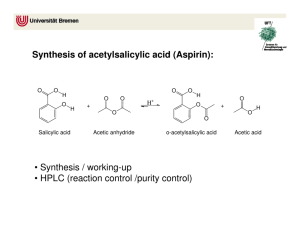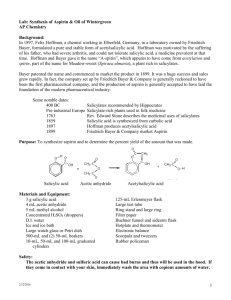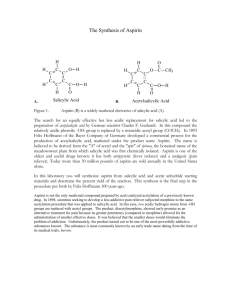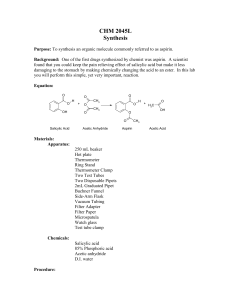Synthesis of Aspirin
advertisement
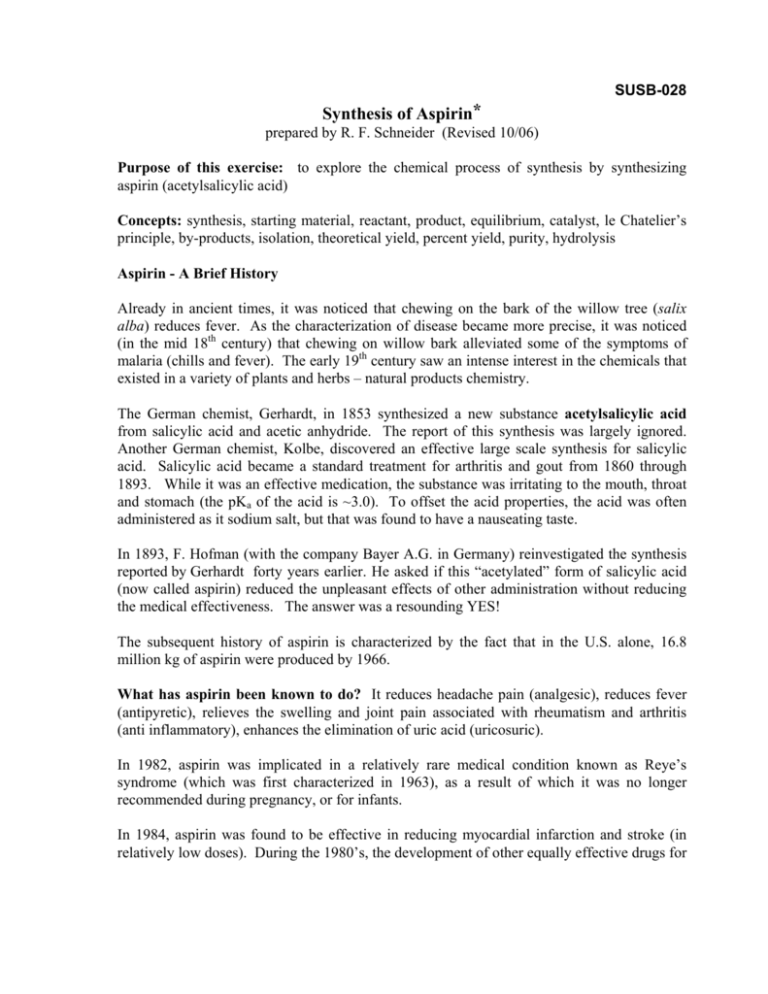
SUSB-028 Synthesis of Aspirin* prepared by R. F. Schneider (Revised 10/06) Purpose of this exercise: to explore the chemical process of synthesis by synthesizing aspirin (acetylsalicylic acid) Concepts: synthesis, starting material, reactant, product, equilibrium, catalyst, le Chatelier’s principle, by-products, isolation, theoretical yield, percent yield, purity, hydrolysis Aspirin - A Brief History Already in ancient times, it was noticed that chewing on the bark of the willow tree (salix alba) reduces fever. As the characterization of disease became more precise, it was noticed (in the mid 18th century) that chewing on willow bark alleviated some of the symptoms of malaria (chills and fever). The early 19th century saw an intense interest in the chemicals that existed in a variety of plants and herbs – natural products chemistry. The German chemist, Gerhardt, in 1853 synthesized a new substance acetylsalicylic acid from salicylic acid and acetic anhydride. The report of this synthesis was largely ignored. Another German chemist, Kolbe, discovered an effective large scale synthesis for salicylic acid. Salicylic acid became a standard treatment for arthritis and gout from 1860 through 1893. While it was an effective medication, the substance was irritating to the mouth, throat and stomach (the pKa of the acid is ~3.0). To offset the acid properties, the acid was often administered as it sodium salt, but that was found to have a nauseating taste. In 1893, F. Hofman (with the company Bayer A.G. in Germany) reinvestigated the synthesis reported by Gerhardt forty years earlier. He asked if this “acetylated” form of salicylic acid (now called aspirin) reduced the unpleasant effects of other administration without reducing the medical effectiveness. The answer was a resounding YES! The subsequent history of aspirin is characterized by the fact that in the U.S. alone, 16.8 million kg of aspirin were produced by 1966. What has aspirin been known to do? It reduces headache pain (analgesic), reduces fever (antipyretic), relieves the swelling and joint pain associated with rheumatism and arthritis (anti inflammatory), enhances the elimination of uric acid (uricosuric). In 1982, aspirin was implicated in a relatively rare medical condition known as Reye’s syndrome (which was first characterized in 1963), as a result of which it was no longer recommended during pregnancy, or for infants. In 1984, aspirin was found to be effective in reducing myocardial infarction and stroke (in relatively low doses). During the 1980’s, the development of other equally effective drugs for enhancing uric acid elimination (as in gout) caused aspirin no longer to be recommended for that use. In recent years, aspirin has been identified as a possible inhibitor of colon cancer. Does the scope of the physiological functions of aspirin suggest some common biochemical mechanisms? The answer appears to be that much of aspirin’s action depends on its ability to interfere with the body’s production of a class of HO O compounds called prostaglandins and their end C products, thromboxanes. These compounds are OH known to be the cause of headaches, platelet aggregation (which can cause blood clots) and vasoO constriction (i.e., the shrinking of the blood vessels). OH A PROSTAGLANDIN true wonder drugs. The synthesis of aspirin 1. Establishing the starting materials and the reaction: O C The structure of the aspirin molecule is shown at the left. The choice of appropriate starting materials and reactions requires knowledge of the availability of related substances and reactions that they undergo. OH O CH3 O Salicylic acid (shown on the right), is easily synthesized and available. The question remains: how does one Aspirin convert the H of the OH group directly connected to the benzene ring to the CH3CO (acetyl) group in aspirin? O OH OH Organic chemistry provides a general synthetic process for such a conversions. In our case, the reaction is that between salicylic acid and a compound closely related to acetic acid, namely acetic anyhdride. Acetic Salicylic Acid anhydride results from the elimination of a molecule of water from two molecules of acetic acid as shown in the following diagram. Acetic anydride is a common reagent. H H C O H C H O ACETIC ACID H H O C C H H H O ACETIC ACID H H C C O H C C H H O O ACETIC ANHYDRIDE We have now established reasonable starting materials and an appropriate reaction for the synthesis of aspirin. The starting materials are salicylic acid and acetic anydride, both of which are easily available and inexpensive. Our reaction becomes: C C CH3 C O O CH3 C + O HO O HO O OH C CH3 O O ACETIC ANHYDRIDE (AA) SALICYLIC ACID (SA) ACETYLSALICYLIC ACID (ASA) + H3 C Observe that the reaction produces a second product, acetic acid. C O H O ACETIC ACID 2. The reaction conditions: The conditions under which the reaction should be conducted depend on some of the properties of the reactants and the products. Acetic anhydride is a liquid at room temperature and boils at temperatures well above 100oC. It reacts with water to form acetic acid – the reverse of the reaction shown above for its formation. Salicylic acid and aspirin are both solids that melt at temperatures well above 100oC. They are both slightly soluble in cold water (2.2 mg/mL and 3.3 mg/mL, respectively). From these properties, we deduce that water is an inappropriate solvent in which to carry out this reaction since water would destroy one of the reactants. Since acetic anhydride is a liquid, we can consider using this starting material as the solvent as well. This is, in fact, what we do. Since the reaction is slow in pure acetic anhydride, we use a well established catalyst for the reaction, namely, a strong acid (we use concentrated sulfuric acid). By le Chatelier’s principle, the presence of an excess of acetic anhydride forces the equilibrium towards the desired product, aspirin. We also heat the solution to accelerate the approach to equilibrium. 3. Isolation of the product: When the reaction has proceeded to its final state, in addition to aspirin, the reaction vessel will contain: unreacted acetic anhydride, unreacted salicylic acid (possibly), acetic acid and the catalyst, sulfuric acid. A pre-laboratory exercise addresses the amounts of each of these substances. We have noted that both aspirin and salicylic acid are only slightly soluble in water. After the reaction is complete, we can consider adding water to the reaction vessel. What should we expect as a result? The water will react with the acetic anhydride (producing yet more acetic acid). If we use a relatively small amount of water, only small amounts of the aspirin and salicylic acid will dissolve and the bulk will form a precipitate in the water solution. Since the solubility of most substances decreases with decreasing temperature, we use cold water (or ice) to further limit the solubility of the aspirin. The acetic acid that formed as a product (and as the result of the reaction of excess acetic anhydride with water) will dissolve in the water and remain in the liquid. Therefore, we are able to recover the aspirin by filtering the cold solution. However, any unreacted salicylic acid will also be recovered along with the aspirin. 4. Effectiveness of the synthesis (yield) and purity of the product The remaining issues are: how much of the final product, aspirin, have we produced and, how pure is the product? From the amounts of the starting materials and observations on the limiting reagent (pre-laboratory exercise), we can calculate the maximum amount that could be produced – i.e., if the reaction had gone “to completion”. The stoichiometry of the reaction shows that 1mol of acetic anhydride reacts with 1 mol of salicylic acid to produce 1 mol of aspirin. Suppose we began with 1.38 g of salicylic acid (138 g/mol) which is 0.01 mol or 10 mmol. The maximum amount of aspirin (180 g/mol) we can make is 0.01 mol or 10 mmol, i.e., 1.80 g. We call this maximum amount the theoretical yield. If, for whatever reason, the reaction did not go “to completion”, or if we lost some of the aspirin through solubility in the water that we add at the completion of the reaction, we would expect to get less than the theoretical yield. Suppose the actual amount (actual yield) of aspirin produced is 1.50 g. We define the percent yield (% yield) as the quantity: % yield = 100% x actual yield / theoretical yield In the current example, the % yield is 100% x 1.50 / 1.80 = 83.3 % Note that in defining the theoretical yield, we calculate the maximum amount of the desired product. In the current exercise, even if the final material were dry, it could contain some unreacted salicylic acid. In fact, if the reaction had not proceeded at all (e.g., if we forgot to add the sulfuric acid catalyst), the isolation process would recover most of the original starting salicylic acid. The weight of the final product would then not be the weight of aspirin. E.g., in the above example, we could recover up to 1.5 g of “product” without having prepared aspirin at all. The computation of the percent yield requires a measure of the assay -- a determination of the extent to which the product contains aspirin -- and purity of the product – a test that indicates the extent to which the product contains anything other than aspirin. In the case of aspirin, a relatively simple qualitative test can detect the presence of salicylic acid in the final product. 5. Ferric Chloride Test for Salicylic Acid: The addition of ferric chloride to salicylic acid produces a specific color caused by the reaction of salicylic acid with aqueous ferric (Fe(H2O)6+3) ion. The oxygen atoms of the acid group –COOH, and of the -OH group on the salicylic acid together can form a complex with Fe(H2O)6+3 as shown below. That complex has an intense violet color. In aspirin, the -OH group of salicylic acid has been replaced by a O-COCH3 group which prevents the second bond from being formed. The resulting complex with aspirin shows only a slight yellow color, not very different from that of Fe(H2O)6+3 itself. The violet color of the salicylic acid complex 3+ OH2 O OH2 H2O Fe OH2 + H2O O OH2 O 2- 1+ OH2 OH2 H2O Fe O H2O O O YELLOW PURPLE will form the basis for a colorimetric determination of the purity of aspirin in another exercise. A second qualitative test can verify the presence of aspirin in the final product. Aspirin is known to be unstable in the presence of moisture at elevated temperatures. At those temperatures, aspirin hydrolyzes (i.e., reacts with water) to decompose into salicylic acid and acetic acid. Acetic acid has a characteristic pungent smell. The hydrolysis reaction is shown below. The detection of this odor depends on the assumption that all of the acetic acid (which was both a product in the reaction and produced from the hydrolysis of excess acetic anhydride) was removed from the sample in the final washing process. COOH COOH O CH3 + H2O O OH + CH3COOH Suppose the heat test indicates the presence of aspirin and the ferric chloride test indicates no detectable salicylic acid. What are the implications on the purity of the product. That issue depends on a variety of additional properties of the synthesis. Some of these are: • did any side reactions between the components in the reaction mixture produce byproducts? If so, do the by-products have unwanted properties in the amounts produced • were the starting materials and other reagents themselves pure? This includes the solvents that are used to wash the product (in this case, water) • was the reaction carried out in a way that could result in microbial contamination? Since aspirin is a pharmaceutical normally intended for human (or animal) consumption, the actual purity of the final aspirin product requires careful attention to such questions. In some instances, an attractive synthetic pathway can be less appropriate than an alternate (and occasionally more expensive) reaction. In fact, the synthesis described above produces pure aspirin and is, therefore, a major commercial process. We employ one additional measure of assay and purity, namely the infrared spectrum of the product. The infrared absorption spectra of aspirin and salicylic acid each contain features unique to the materials. Within the limits of detectability of the infrared technique, we can verify the qualitative composition of the product by comparing the spectrum of the product with the spectra of authentic aspirin and salicylic acid. PRECAUTIONS: Acetic Anhydride: Corrosive, Flammable and Lachrymator (produces tearing of the eyes) Concentrated Sulfuric Acid: Very Corrosive Ferric Chloride Solution: Corrosive Salicylic Acid and Aspirin: Pulmonary Irritants- Don’t inhale dust Ethanol: Toxic and Flammable Personal belongings: The only items on the desk should be your laboratory notebook, this exercise and the apparatus used in the exercise. Personal items should never be on the laboratory desk. In this exercise, that is absolutely essential. Wash your hands after handling the reagents in this exercise. PROCEDURE: BE SURE TO RECORD ALL DATA IN LAB NOTEBOOK Synthesis: 1. Set up a secure water bath as shown in the diagram using a ring, wire gauze, extension clamp (which will be used to hold a 125 mL Erlenmeyer flask) and Bunsen burner. Begin heating the water. A 600 mL beaker will accommodate the flask well. 2. Weigh approximately 2 grams of salicylic acid, using a watch glass, on the top loading balance. Record the weight to the full precision of the balance. 3. Transfer the salicylic acid completely to a clean, dry 125 mL Erlenmeyer flask. 4. In the hood, transfer 4.0 mL of acetic anhydride into the 125 mL Erlenmeyer flask using a Dewick pipet. 5. In the hood, carefully add 5 drops of concentrated sulfuric acid to the Erlenmeyer flask using the dropper provided. Be careful not to let the sulfuric acid drop anywhere other than into the flask. If any acid does spill anywhere, advise the teaching assistant immediately. Swirl the flask to help mix the contents. Do not add the sulfuric acid before the acetic anhydride. The reaction mixture should form a clear solution as it is heated. 6. Bring the flask back to the desk. Place it in the extension clamp (tilting the flask will help minimize boil over). Make sure the reaction mixture is below the liquid level in the bath and that the water is boiling. Heat in the boiling water bath for not less than 20 minutes by which time all of the solid should have dissolved. 7. Obtain 50 mL of ice water in a 150 mL beaker. After removing the flask from the water bath, measure 10 mL of ice water in a 10 mL graduated cylinder and add it to the reaction mixture, 3-5 drops at a time, to hydrolyze the unreacted acetic anhydride. 8. Chill the Erlenmeyer flask in an ice bath with occasional swirling to cause precipitation of the product. Add 25 mL of ice water to the reaction mixture. If no precipitate forms, scratching the side of the flask with a glass stirring rod may help initiate crystallization. While the flask is chilling, prepare a vacuum filtration apparatus as shown at the left. Isolation of the Product: 9. Weigh a piece of filter paper on a watchglass. Record the weight of the paper + the watchglass. Place the weighed paper in the Buchner funnel. Wet the paper with a small amount of water using your wash bottle to seal the paper to the funnel surface. 10. Turn on the aspirator. Swirl the flask and pour its contents carefully onto the center of the filter paper. Use a stirring rod with a rubber policeman to assist in getting all of the solid out of the flask. 11. When all the solid has been captured on the filter paper and the liquid has all been sucked through, wash the product by slowly pouring a measured amount of ice water, not to exceed 15 mL, on the surface of the precipitate. Decrease the aspirator flow and adjust it so the liquid is removed at a very slow drop rate. This is to wash the precipitate to remove any remaining acetic acid. 12. Take a very small amount (50 mg) of the sample and place it on a watch glass. We will use this amount to perform some tests. It can be dried on the laboratory ventilators. 13. Transfer the filter paper and remaining product to a clean 150 mL beaker by inserting a clean spatula under the bottom of the filter paper to peel it away from the funnel. Place the beaker in your drawer where the contents will be allowed to dry until next week. The dry product will be weighed next week. Qualitative Tests of the Purity of the Product: Ferric Chloride Test Into each of three clean and dry small test tubes, place 1 mL of ethanol (ethyl alcohol) and one drop of 1% aqueous ferric chloride solution. Into the first, place a few crystals (about 5 mg) of salicylic acid. Into the second, place the same amount of your product from the 50 mg sample on the watch glass in step 12, above. The third tube is used as a control (blank). Shake the mixture in each test tube. Record the results in your notebook and on the data sheet. Comment on the significance of the results – in particular, how it relates to the purity of your product. Heat test To another clean small test tube, add a few crystals (about 10 mg) of your product, again, from the 50 mg sample on the watch glass in step 12, above. Heat it gently to melting. Remove from the heat and note the odor of the escaping vapor by carefully fanning the vapors with your hand toward your nose. Comment on the odor and on the implications on the purity of your product. Melting Point As you have learned in earlier exercises, a melting point is an effective way of determining both the identity of a substance and its purity. The melting point of a substance under prescribed conditions of pressure (usually, 1 atm) is a characteristic property of that substance. Indeed, the Handbook of Chemistry and Physics indexes its extensive list of the properties of organic compounds by melting points. For a sample of a known substance, the melting point provides a second useful type of information. You should be familiar with the phenomenon of freezing point depression – the lowering of the melting point of one substance when a second substance is dissolved in the liquid form of the first substance. Based on this principle, we expect that the melting point of a substance will be lower if it is impure than if it is pure. The deviation of a melting temperature of a sample of a substance from the accepted melting point for that substance can be an indication of the existence of an impurity. The extent to which freezing points are depressed by impurities is not very large. For water, dissolving one mole of a substance in 1kg of water causes a depression of only a little less than 2 oC. In the laboratory, we can turn this logic around to our benefit– even when we deal with pure but unknown substances. We measure the melting point of our tentatively identified substance with a result of 99 ± 1oC. We measure the melting point of an authentic sample of the same substance to be 100 ± 1oC. If the melting point of a mixture of our substance and the authentic sample is substantially less than 100 oC, we have strong evidence that the two substances are different and what we are observing is the freezing point depression of both of the components of the mixture. If, on the other hand, the result is near 100 oC, we have strong evidence that the two substances are the same. The above procedure is called the determination of a mixed melting point. SUSB-028 Data Sheet SYNTHESIS OF ASPIRIN ___________________________________________________________________________ Name Section Date Weight of Watch Glass and Salicylic Acid ……………………. g Weight of Empty Watch Glass…………………………………. g Weight of Salicylic Acid……………………………………….. g Volume of Acetic Anhydride ………………………………….. mL Volume of Concentrated Sulfuric Acid …………. ….………… drops Time of heating ………………………………………………. min Total amount of water added to product …………………….. mL Weight of Filter Paper plus Product………………………….. g Weight of Dry Filter Paper……………………………………. g Weight of Product ……………………………………………. g Theoretical Yield (based on limiting reagent) .……………….. g Percent Yield…………………………………………………. % Estimated loss in washing (at 3.3 mg / mL)…………………… g Melting point of product……………………………………… (over) Result and Interpretation of Ferric Chloride Test: ___________ oC Salicylic Acid_____________________________________________________________ Your Product Control__________________________________________________________________ Interpretation: ____________________________________________________________ ________________________________________________________________________ Result and Interpretation of Heat Test: Result __________________________________________________________________ ________________________________________________________________________ Interpretation: ____________________________________________________________ ________________________________________________________________________ Comment on any other observations from your notebook that bear on your percent yield, the tests or any other aspect of the exercise. SUSB-028 Pre-Laboratory Assignment ___________________________________________________________________________ Name Section Date 1. A sample of salicylic acid weighing (1.00 g + the last three digits of your USB ID in mg) and the prescribed amounts of the other reagents are used in the synthesis of aspirin. The density of acetic anhydride is 1.08 g/mL. The density of concentrated sulfuric acid is 1.85 g/mL. a.) How many millimoles of each of the following are initially in the reaction vessel? Salicylic Acid Acetic Anhydride Sulfuric Acid (1 drop = 0.05 mL) b.) What is the limiting reagent? c.) If the reaction proceeds with total consumption of the limiting reagent, how many millimoles of each of the following are finally in the reaction vessel? Salicylic Acid Acetic Anhydride Sulfuric Acid Aspirin d.) What is the theoretical yield for the reaction? 2. If 2.00 g of salicylic acid is used in the synthesis and the weight of the final product is 2.10 g. What is the percent yield? (Over) 3. A total of 50 mL of ice water are used in processing the final reaction mixture (including the water used to rinse the precipitate). How many grams of aspirin could be lost in this process? (assume the solubility of aspirin in ice water is the same as at 25oC.) 4. Another student, Gehardt Bayer, forgets to add concentrated sulfuric acid to the reaction mixture. What would you expect the ferric chloride test to show? Why? Optional Question: O C OH H O H H H CH3 O Depending on the details of the mechanism (molecular pathway) of the reaction between salicylic acid and acetic anhydride, the oxygen atom connected to the benzene ring in the product, aspirin, could conceivably have been part of the original salicylic acid molecule or the acetic anhydride molecule. Can you devise an experiment to establish which is the case? [Hint: How can a particular atom in the structure of a molecule be distinguished from other atoms of the same element in the same molecule?]
